Related Research Articles
Abstract expressionism in the United States emerged as a distinct art movement in the immediate aftermath of World War II and gained mainstream acceptance in the 1950s, a shift from the American social realism of the 1930s influenced by the Great Depression and Mexican muralists. The term was first applied to American art in 1946 by the art critic Robert Coates. Key figures in the New York School, which was the epicenter of this movement, included such artists as Arshile Gorky, Jackson Pollock, Franz Kline, Mark Rothko, Norman Lewis, Willem de Kooning, Adolph Gottlieb, Clyfford Still, Robert Motherwell and Theodoros Stamos among others.

Frank Philip Stella was an American painter, sculptor, and printmaker, noted for his work in the areas of minimalism and post-painterly abstraction. He lived and worked in New York City for much of his career before moving his studio to Rock Tavern, New York. Stella's work catalyzed the minimalist movement in the late 1950s. He took a reductionist approach to his art, saying he wanted to demonstrate that for him, every painting is "a flat surface with paint on it—nothing more", and disavowed conceptions of art as a means of expressing emotion. He won notice in the New York art world in 1959 when his four black pinstripe paintings were shown at the Museum of Modern Art. Stella was a recipient of the National Medal of Arts in 2009 and the Lifetime Achievement Award in Contemporary Sculpture by the International Sculpture Center in 2011.
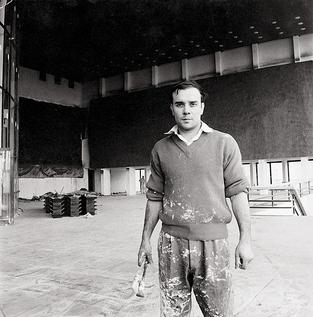
Yves Klein was a French artist and an important figure in post-war European art. He was a leading member of the French artistic movement of Nouveau réalisme founded in 1960 by art critic Pierre Restany. Klein was a pioneer in the development of performance art, and is seen as an inspiration to and as a forerunner of minimal art, as well as pop art. He is known for the development and use of International Klein Blue.

Monochromatic painting has played a significant role in modern and contemporary Western visual art, originating with the early 20th-century European avant-gardes. Artists have explored the non-representational potential of a single color, investigating shifts in value, diversity of texture, and formal nuances as a means of emotional expression, visual investigation into the inherent properties of painting, as well as a starting point for conceptual works. Ranging from geometric abstraction in a variety of mediums to non-representational gestural painting, monochromatic works continue to be an important influence in contemporary art.

Franz Kline was an American painter. He is associated with the Abstract Expressionist movement of the 1940s and 1950s. Kline, along with other action painters like Jackson Pollock, Willem de Kooning, Robert Motherwell, John Ferren, and Lee Krasner, as well as local poets, dancers, and musicians came to be known as the informal group, the New York School. Although he explored the same innovations to painting as the other artists in this group, Kline's work is distinct in itself and has been revered since the 1950s.

Color field painting is a style of abstract painting that emerged in New York City during the 1940s and 1950s. It was inspired by European modernism and closely related to abstract expressionism, while many of its notable early proponents were among the pioneering abstract expressionists. Color field is characterized primarily by large fields of flat, solid color spread across or stained into the canvas creating areas of unbroken surface and a flat picture plane. The movement places less emphasis on gesture, brushstrokes and action in favor of an overall consistency of form and process. In color field painting "color is freed from objective context and becomes the subject in itself."
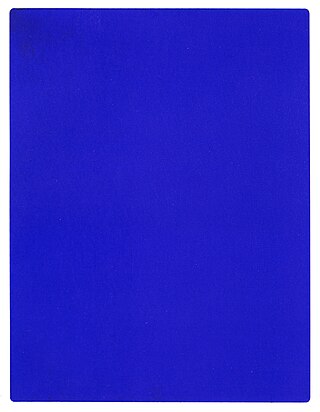
International Klein Blue (IKB) is a deep blue hue first mixed by the French artist Yves Klein. IKB's visual impact comes from its heavy reliance on ultramarine, as well as Klein's often thick and textured application of paint to canvas.
Shaped canvases are paintings that depart from the normal flat, rectangular configuration. Canvases may be shaped by altering their outline, while retaining their flatness. An ancient, traditional example is the tondo, a painting on a round panel or canvas: Raphael, as well as some other Renaissance painters, sometimes chose this format for madonna paintings. Alternatively, canvases may be altered by losing their flatness and assuming a three-dimensional surface. Or, they can do both. That is, they can assume shapes other than rectangles, and also have surface features that are three-dimensional. Arguably, changing the surface configuration of the painting transforms it into a sculpture. But shaped canvases are generally considered paintings.

Robert Ryman was an American painter identified with the movements of monochrome painting, minimalism, and conceptual art. He was best known for abstract, white-on-white paintings. He lived and worked in New York City.
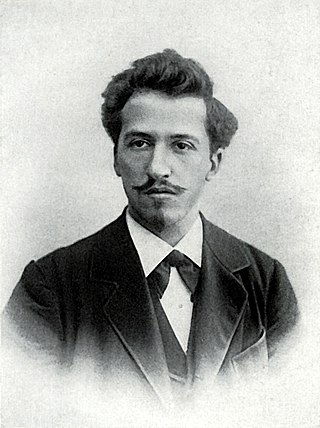
Pieter Cornelis Mondriaan, after 1906 known as Piet Mondrian, was a Dutch painter and art theoretician who is regarded as one of the greatest artists of the 20th century. He is known for being one of the pioneers of 20th-century abstract art, as he changed his artistic direction from figurative painting to an increasingly abstract style, until he reached a point where his artistic vocabulary was reduced to simple geometric elements.

Archibald John Motley, Jr., was an American visual artist. Motley is most famous for his colorful chronicling of the African-American experience in Chicago during the 1920s and 1930s, and is considered one of the major contributors to the Harlem Renaissance, or the New Negro Movement, a time in which African-American art reached new heights not just in New York but across America—its local expression is referred to as the Chicago Black Renaissance. He studied painting at the School of the Art Institute of Chicago during the 1910s, graduating in 1918.
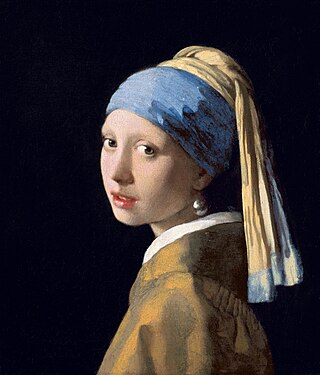
The history of Western painting represents a continuous, though disrupted, tradition from antiquity until the present time. Until the mid-19th century it was primarily concerned with representational and traditional modes of production, after which time more modern, abstract and conceptual forms gained favor.

20th-century Western painting begins with the heritage of late-19th-century painters Vincent van Gogh, Paul Cézanne, Paul Gauguin, Georges Seurat, Henri de Toulouse-Lautrec, and others who were essential for the development of modern art. At the beginning of the 20th century, Henri Matisse and several other young artists including the pre-cubist Georges Braque, André Derain, Raoul Dufy and Maurice de Vlaminck, revolutionized the Paris art world with "wild", multi-colored, expressive landscapes and figure paintings that the critics called Fauvism. Matisse's second version of The Dance signified a key point in his career and in the development of modern painting. It reflected Matisse's incipient fascination with primitive art: the intense warm color of the figures against the cool blue-green background and the rhythmical succession of the dancing nudes convey the feelings of emotional liberation and hedonism.
Pattern and Decoration was a United States art movement from the mid-1970s to the early 1980s. The movement has sometimes been referred to as "P&D" or as The New Decorativeness. The movement was championed by the gallery owner Holly Solomon. The movement was the subject of a retrospective exhibition at the Hudson River Museum in 2008.

Minimalism describes movements in various forms of art and design, especially Visual art and music, where the work is set out to expose the essence, essentials or identity of a subject through eliminating all non-essential forms, features or concepts. As a specific movement in the arts it is identified with developments in post–World War II Western Art, most strongly with American visual arts in the 1960s and early 1970s. Minimalism is often interpreted as a reaction to abstract expressionism and a bridge to postminimal art practices. Prominent artists associated with this movement include Ad Reinhardt, Nassos Daphnis, Tony Smith, Donald Judd, John McCracken, Agnes Martin, Dan Flavin, Robert Morris, Larry Bell, Anne Truitt, Yves Klein and Frank Stella. Artists themselves have sometimes reacted against the label due to the negative implication of the work being simplistic.
Charles Hinman born 1932 in Syracuse, New York is an Abstract Minimalist painter, notable for creating three-dimensional shaped canvas paintings in the mid-1960s.
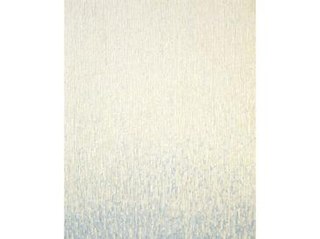
Chung Sanghwa is a South Korean minimalist and Dansaekhwa artist. After receiving his BFA from the College of Fine Arts in Seoul National University in 1956, Chung developed his unique grid-like painting style in Japan and France in the late 1970s and early 1980s. Coming from a generation of post-war South Korean artists, Chung's reductive process of painting consists of repetitive application and removal of the paint on canvas.

Dansaekhwa, often translated as "monochrome painting" from Korean, is a retroactive term grouping together disparate artworks that were exhibited in South Korea beginning in the mid 1970s. While the wide range of artists whose work critics and art historians consider to fall under this category are often exhibited together, they were never part of an official artistic movement nor produced a manifesto. Nonetheless, their artistic practices are seen to share "a commitment to thinking more intensively about the constituent elements of mark, line, frame, surface and space around which they understood the medium of painting." Their interests compose a diverse set of formal concerns that cannot be reduced to a preference for limited color palettes.
Ethan Cook is a Brooklyn-based contemporary and process artist best known for his large-scale canvases of unmodulated color blocks that he partially weaves himself. Cook creates work with the appearance of a traditional, nonobjective painting; however, his work does not contain any paint, only carefully woven fabric. Cook's process work has been likened to the work of Abstract Expressionists Mark Rothko and Agnes Martin, and his art has been featured in the Los Angeles Times, the New York Times, Architectural Digest and Interview Magazine, among other publications.
Chung Chang-sup was a Korean abstract painter and first-generation member of the post-war art movement, Dansaekhwa. At the start of his career he worked with oil paint as his main medium, but later on he explored Korean materials such as hanji and ink paints. Since he held close relations to government elite, he was able to have success as an oil painter hired as a part of the state-sponsored National Painting Project. His lifelong explorations with hanji pulp, called tak, are more well-known and became his trademark. Chung's unique approach to Korean materials was inspired by Eastern philosophies regarding harmony and nature. As one of the leading innovators of Dansaekwa, Chung's works were, and continue to be exhibited internationally in group and solo shows.
References
- ↑ Vogel, Maria (2021-03-19). "Artist Byron Kim's Deceptively Modest Meditations on Identity Pose Important Questions—Here Are 3 Facts to Know About His Work". Artnet News. Retrieved 2023-07-10.
- ↑ Berwick, Carly (2011-04-23). "Stranger in America". ARTnews.com. Retrieved 2022-04-29.
- 1 2 3 Carey Lovelace, Byron Kim at Max Protetch - Brief Article, Art in America, October 2001.
- 1 2 Michael Kelly in Salim Kemal, Ivan Gaskell, Politics and Aesthetics in the Arts, Cambridge University Press, 2000, p249. ISBN 0-521-45418-2
- ↑ Michael Kelly in Salim Kemal, Ivan Gaskell, Politics and Aesthetics in the Arts, Cambridge University Press, 2000, pp249-250. ISBN 0-521-45418-2
- ↑ Erika Doss, Twentieth-Century American Art, Oxford University Press, 2002, p237. ISBN 0-19-284239-0
- ↑ Grace Glueck, Art in Review, The New York Times, Dec 9, 2005.
- ↑ "Byron Kim".